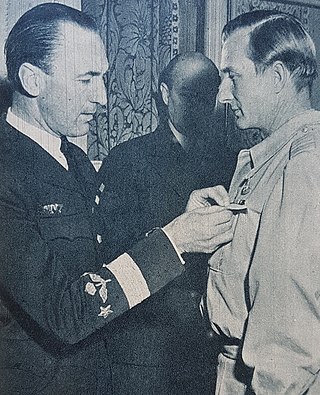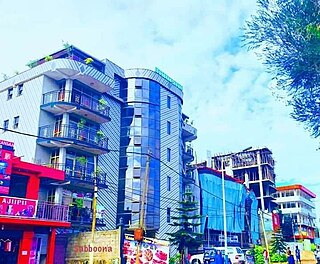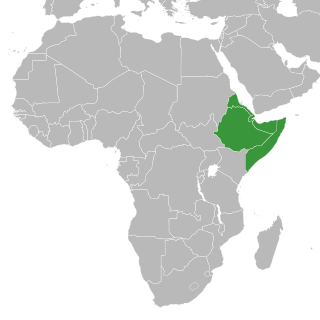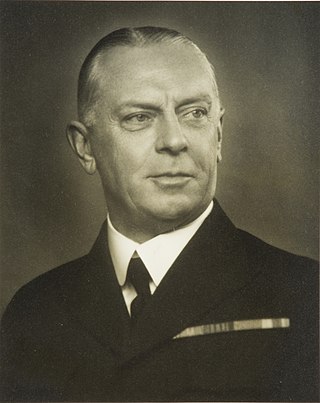
The Abyssinia Crisis, also known in Italy as the Walwal incident, was an international crisis in 1935 that originated in a dispute over the town of Walwal, which then turned into a conflict between the Fascist-ruled Kingdom of Italy and the Ethiopian Empire. The League of Nations ruled against Italy and voted for economic sanctions, but they were never fully applied. Italy ignored the sanctions, quit the League, made special deals with the United Kingdom and France and ultimately annexed and occupied Abyssinia after it had won the Second Italo-Ethiopian War. The crisis is generally regarded as having discredited the League.

Count Carl Gustaf Ericsson von Rosen was a Swedish pioneer aviator, humanitarian, and mercenary pilot. He flew relief missions in a number of conflicts as well as combat missions for Finland and Biafra. His flights for the Biafran Air Force were notable for using the small Malmö MFI-9 in a ground attack role.

The Stresa Front was an agreement made in Stresa, a town on the banks of Lake Maggiore in Italy, between French prime minister Pierre-Étienne Flandin, British prime minister Ramsay MacDonald, and Italian prime minister Benito Mussolini on 14 April 1935. Practically, the Stresa Front was an alliance between France, Italy, and the United Kingdom, aimed against Nazi Germany. Pat Buchanan's Churchill, Hitler and the Unnecessary War considered the Stresa Front the last chance to stop Hitler before the Second World War.

Dire Dawa is a city in eastern Ethiopia near the Somali Region and Oromo border and one of two chartered cities in Ethiopia. Dire Dawa alongside present-day Sitti Zone were a part of the Dire Dawa autonomous region of the Somali Region stipulated in the 1987 Ethiopian Constitution until 1993 when it was split by the federal government into a separately administered chartered city.
The Hoare–Laval Pact was an initially secret pact made in December of 1935 between French Foreign Minister Pierre Laval and British Foreign Secretary Sir Samuel Hoare for ending the Second Italo-Ethiopian War. Italy wanted to incorporate the independent nation of Abyssinia (Ethiopia) into its Italian Empire and also avenge the 1896 Battle of Adwa, a humiliating defeat. The pact proposed to partition Abyssinia and thus partially achieve Italian dictator Benito Mussolini's goal of making Abyssinia an Italian colony.

Jimma is the largest city in southwestern Oromia Region, Ethiopia. It is a special zone of the Oromia Region and is surrounded by Jimma Zone. It has a latitude and longitude of 7°40′N36°50′E. Prior to the 2007 census, Jimma was reorganized administratively as a special Zone.
Gore is a town in south-western Ethiopia. Located south of Metu in the Illubabor Zone of the Oromia Region, this town has a latitude and longitude of 8°9′N35°31′E and an elevation of 2085 meters.

Nekemte, also spelled as Neqemte, is a market city and separate woreda in western Ethiopia. Located in the East Welega Zone of the Oromia Region, Nekemte has a latitude and longitude of 9°5′N36°33′E and an elevation of 2,088 meters.

Conflicts in the Horn of Africa have been occurring since the 17th century BCE. The Horn of Africa includes the nations of Djibouti, Eritrea, Ethiopia, and Somalia.

The Army of the Ethiopian Empire was the principal land warfare force of the Ethiopian Empire and had naval and air force branches in the 20th century. The organization existed in multiple forms throughout the history of the Ethiopian Empire from its foundation in 1270 by Emperor Yekuno Amlak, to the overthrow of the monarchy and Emperor Haile Selassie in 1974 by members of the Ethiopian army. Due to the country's position along multiple trade routes and its maintenance of independence against multiple Islamic and colonialist invasions lead to multiple conflicts against numerous major countries including the Ottomans, Egyptians, British, and Italians.
The Heinkel HD 21 was a trainer built in Germany during the 1920s. It was a conventional single-bay biplane with staggered wings braced with N-type interplane struts. The main units of the fixed, tailskid undercarriage were linked by a cross-axle, and the aircraft had three open cockpits in tandem, although one of these was typically faired over. The HD 29 of 1925 was essentially similar, but was purely a two-seater.

The Italo-Ethiopian Treaty of 1928, also known as the Italo–Ethiopian Treaty of Friendship and Arbitration, was a treaty signed between the Kingdom of Italy and the Ethiopian Empire on 2 August 1928. Nigiste Negest Zewditu I ruled Ethiopia at the time of this treaty, but it was the 36-year-old Ras Tafari Makonnen who represented the government of Ethiopia. Tafari, who was still in his minority, was heir apparent and Regent Plenipotentiary.
De Bono's invasion of Ethiopia took place during the opening stages of the Second Italo-Ethiopian War. Italian General Emilio De Bono invaded northern Ethiopia from staging areas in the Italian colony of Eritrea on what was known as the "northern front".

Ethiopia is one of the oldest countries in Africa; the emergence of Ethiopian civilization dates back thousands of years. Abyssinia or rather "Ze Etiyopia" was ruled by the Semitic Abyssinians (Habesha) composed mainly of the Amhara, Tigrayans and the Cushitic Agaw. In the Eastern escarpment of the Ethiopian highlands and more so the lowlands were the home of the Harari/Harla that founded Sultanates such as Ifat and Adal and the Afars. In the central and south were found the ancient Sidama and Semitic Gurage, among others.
Getachew Abate (1895–1952) was an army commander and a member of the nobility of the Ethiopian Empire.
The Battle of Anchem was fought between two factions of the Royal family in the Ethiopian Empire. The battle was fought to determine who would rule the empire, Empress Zewditu or King (Negus) Tafari Makonnen.
Gugsa Wale's rebellion of 1930 was a rebellion raised by Ras Gugsa Wale and by supporters of Empress Zewditu to rid her of the Crown Prince and heir apparent, Negus Tafari Makonnen. With Tafari gone, Zewditu would be the sole claimant to succession as the ruler of the Ethiopian Empire. As the husband of Empress Zewditu, Gugsa Wale expected to become Emperor.
Yilma Deressa was an Ethiopian politician member of the Welega aristocracy. He served as Finance Minister (1957–1970) and Minister of Foreign Affairs (1958-1960), Ambassador to the United States, and member of the Ethiopian Senate. John Spencer includes him in his list of five public figures who occupied the most important posts for the two decades following the Second World War.

Major General Eric Virgin was a Swedish Air Force officer. Originally a Swedish Army officer, Virgin became commanding officer of the Svea Logistic Corps in 1926 and was appointed Inspector of the Swedish Army Service Troops the year after. In 1931 he was appointed Chief of the Air Force for the newly established Swedish Air Force. Virgin left the position as major general in 1934 to become advisor to the Emperor of Abyssinia. He left Abyssinia two days before the outbreak of the Second Italo-Ethiopian War in 1935; back in Sweden, he was placed in the Swedish Air Force reserve, where he remained until 1947. Virgin died three years later.










